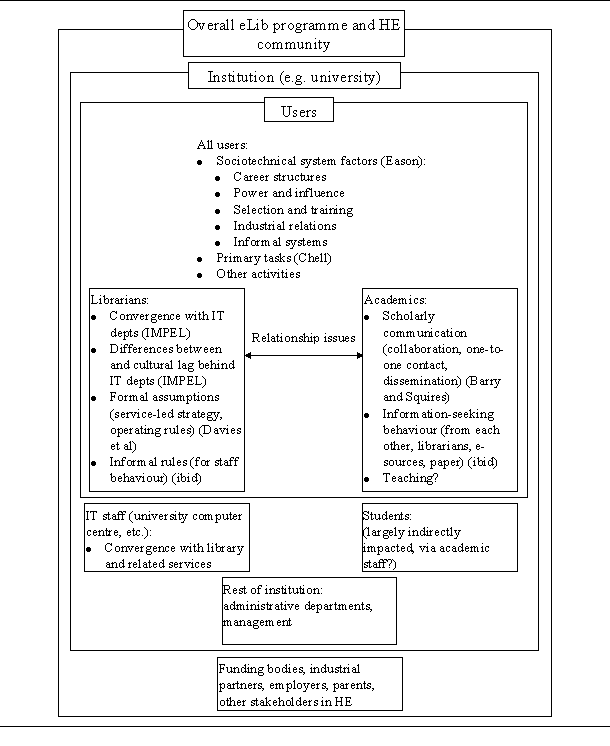
A starting point for modelling cultural change efforts regarding digital library innovations is provided by Kling and Elliott (1994) who focus on the concept of "organisational usability" within this context. Organisational usability refers to the ways that computer systems can be effectively integrated into work practices of specific organisations. The dimensions of organisational usability they give could be seen as aspects of a development which, if successfully achieved, will facilitate cultural change efforts. These dimensions are:
According to Kling and Elliott, these aspects need to be applied to a digital library system in relation to the various stakeholder groups involved in a given project, such as the system developers and support personnel, the librarians and the various groups of end-users (students, researchers, teaching staff). For the present eLib Supporting Study, the stakeholder groups identified by Kling and Elliott need to be revised to fit the UK HE context. This has been done in the model presented below.
Analysis of behavioural change following the introduction of technology can also be considered at a number of levels, from the individual user to the overall society in which they live. In the present context, drawing on three levels of cultural impact of IT as outlined by Ruhleder (1995), the following levels at which cultural change could be identified may be outlined as follows:
Level 1: Individual
Level 2: Local organisation (academic department or library)
Level 3a: The whole academic institution (e.g. university)
Level 3b: The discipline or profession as a whole
Diagrammatically, this can be represented as:

As stated in the Call for Proposals for the present Supporting Study, examining cultural change involves paying particular attention to behaviour at the organisational levels of the above diagram, rather than the 'Individual' level which is generally being tackled by evaluation activities within projects and by the Training and Awareness area of eLib.
Kling and Elliott's organisational usability dimensions can be seen as preconditions for desirable cultural change; for example, if the system that is developed is unreliable or fails to fit users' work practices, then unless it is forced upon them it will be underused and unlikely to facilitate cultural change. Other potential causal factors which may influence cultural change can be identified from the literature or from considering the nature of eLib developments, or have been suggested by the Tavistock Institute in their reports to JISC (e.g. Tavistock Institute 1996b, 1997). These may be divided into project-related and organisational factors.
In the model of cultural change that follows, the main emphasis is on the 'users' of an eLib development, rather than other stakeholders. In the present context, 'user' is intended to imply both librarians and academic users of an electronic library development. Where the literature has suggested cultural change factors impacting on only librarians or only on academics, these are identified separately. Other stakeholders may of course undergo cultural change as an indirect result of eLib developments, but it is likely that the primary direct cultural change processes will occur in the librarian and academic communities.
The diagram below shows the main aspects of group and organisational behaviour which, at the start of this Study, the authors saw as likely to be altered in cultural change in the eLib context. The diagram focuses especially on the level which Ruhleder characterised as 'local infrastructure', i.e. that of departments and working groups within a single HEI. However, it is important to recognise that some cultural change would ideally occur at the higher levels of whole institutions, and in all the disciplines and professions involved in eLib initiatives. Note also that the diagram assumes that most eLib projects have been aimed primarily at supporting the research function of universities, rather than being aimed directly at student use. Where students are allowed or intended to directly benefit from a development, changes in their working practices and hence working culture may also exist, but this seems largely to be seen as a secondary benefit of most eLib developments.
The bullet-pointed lists in the diagram below represent expected changes, or aspects of existing activity which may be affected by change, as hypothesised prior to the analyses of deliverables and interviews described later in this report.

Previous section: Literature review
Next section: Applying the model
The Electronic Libraries Programme (eLib) was funded
by the Joint Information Systems Committee (JISC)
Page version: 1;
Web page maintained by
UKOLN Systems Team
and hosted by
UKOLN
- feedback to
systems@ukoln.ac.uk
.
Site last revised on: Tuesday, 24-Nov-1998 14:21:09 UTC
DC Metadata